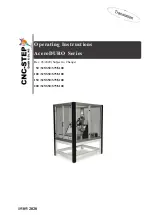
Chapter 1: Configuration
General configuration
Page
1-76
Block and Forward SM Packets to Backbone - This not only prevents
multicast/broadcast and unicast SM-to-SM communication but also sends
the packets, which otherwise are handled SM to SM, through the Ethernet
port of the AP.
Forward Unknown
Unicast Packets
Enabled: All unknown Unicast packets (no entry in the AP’s bridge table)
received via the AP’s Ethernet LAN interface are forwarded to registered
SMs. If the target device is situated beneath a particular SM, when the device
responds the SM and AP will learn and add the device to their bridge tables
so that subsequent packets to that device is bridged to the proper SM.
Disabled: All unknown Unicast packets (no entry in the AP’s bridge table)
received via the AP’s Ethernet LAN interface are discarded at the AP.
Update Application
Address
Enter the address of the server to access for software updates on this AP
and registered SMs.
Prioritize TCP ACK
To reduce the likelihood of TCP acknowledgement packets being dropped,
set this parameter to Enabled. This can improve throughput that the end
user perceives during transient periods of congestion on the link that is
carrying acknowledgements. This parameter, when enabled, can be
particularly useful when running bi-direction FTP sessions over the link. If a
link is primarily used for video surveillance, it is recommended to set this
parameter to Disable.
Multicast Destination
Address
Using Link Layer Discovery Protocol (LLDP), a module exchanges multicast
addresses with the device to which it is wired on the Ethernet interface.
Although some switches (CMM4, for example) do not pass LLDP addresses
upward in the network, a radio can pass it as the value of the Multicast
Destination Address parameter value in the connected device that has it
populated.
DHCP Relay Agent
The AP may act as a DHCP relay for SMs and CPEs underneath it. The AP will
make use of the DHCP Option 82 (DHCP Relay Agent Information) from RFC
3046 when performing relay functions. The AP offers two types of DHCP
relay functionality:
Full Relay Information - Configuring the DHCP Full Relay Operation will
take broadcast DHCP packets and send them to a Unicast server in unicast
mode. This way the DHCP requests and replies can be routed like any other
UDP packet.
Only Insert Option 82 - This option leaves the DHCP request on its
broadcast domain as opposed to DHCP Full Relay Operation which will turn
it into a unicast packet.
In order to accommodate setting up pools or classes for different VLANs,
the Option 82 field will include information to tell the server what VLAN the
client is on.
Summary of Contents for PTP 450 Series
Page 51: ...Chapter 1 Configuration Quick link setup Page 1 23...
Page 155: ...Chapter 1 Configuration Configuring security Page 1 127...
Page 163: ...Chapter 1 Configuration Configuring security Page 1 135...
Page 164: ...Chapter 1 Configuration Configuring security Page 1 136...
Page 193: ...Chapter 1 Configuration Configuring radio parameters Page 1 165...
Page 194: ...Chapter 1 Configuration Configuring radio parameters Page 1 166...
Page 195: ...Chapter 1 Configuration Configuring radio parameters Page 1 167...
Page 206: ...Chapter 1 Configuration Configuring radio parameters Page 1 178...
Page 210: ...Chapter 1 Configuration Configuring radio parameters Page 1 182...
Page 636: ...Chapter 5 Troubleshooting Logs Page 5 16 Figure 95 SM Authorization log...
















































